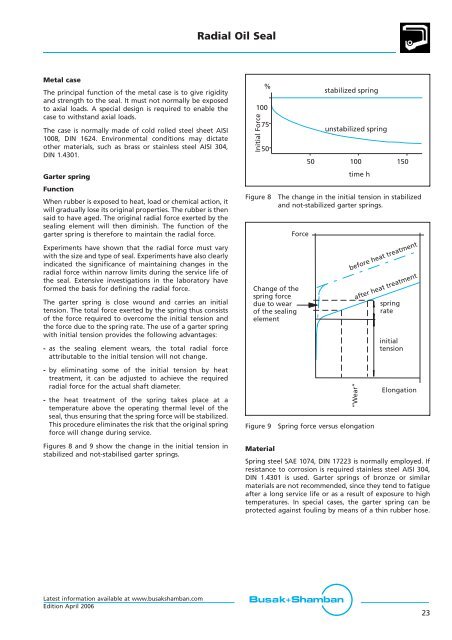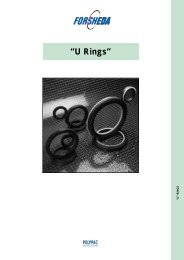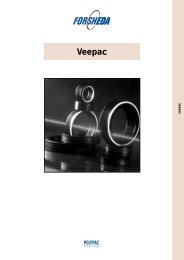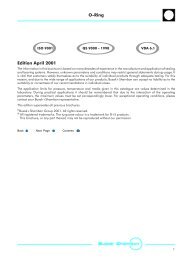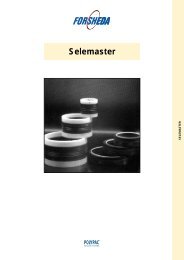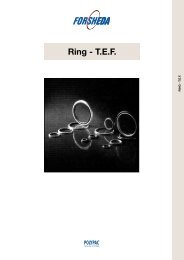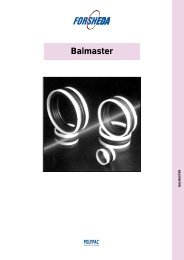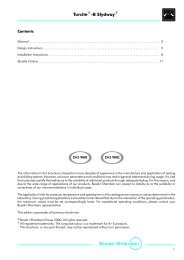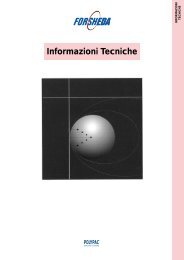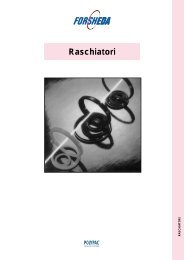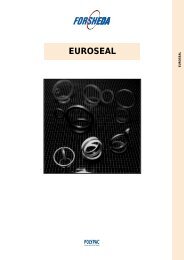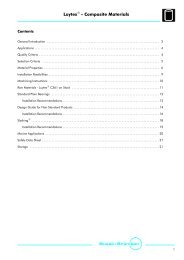Rotary Seals - Dilanda.it
Rotary Seals - Dilanda.it
Rotary Seals - Dilanda.it
Create successful ePaper yourself
Turn your PDF publications into a flip-book with our unique Google optimized e-Paper software.
Radial Oil Seal<br />
Metal case<br />
The principal function of the metal case is to give rigid<strong>it</strong>y<br />
and strength to the seal. It must not normally be exposed<br />
to axial loads. A special design is required to enable the<br />
case to w<strong>it</strong>hstand axial loads.<br />
The case is normally made of cold rolled steel sheet AISI<br />
1008, DIN 1624. Environmental cond<strong>it</strong>ions may dictate<br />
other materials, such as brass or stainless steel AISI 304,<br />
DIN 1.4301.<br />
Garter spring<br />
Function<br />
When rubber is exposed to heat, load or chemical action, <strong>it</strong><br />
will gradually lose <strong>it</strong>s original properties. The rubber is then<br />
said to have aged. The original radial force exerted by the<br />
sealing element will then diminish. The function of the<br />
garter spring is therefore to maintain the radial force.<br />
Experiments have shown that the radial force must vary<br />
w<strong>it</strong>h the size and type of seal. Experiments have also clearly<br />
indicated the significance of maintaining changes in the<br />
radial force w<strong>it</strong>hin narrow lim<strong>it</strong>s during the service life of<br />
the seal. Extensive investigations in the laboratory have<br />
formed the basis for defining the radial force.<br />
The garter spring is close wound and carries an in<strong>it</strong>ial<br />
tension. The total force exerted by the spring thus consists<br />
of the force required to overcome the in<strong>it</strong>ial tension and<br />
the force due to the spring rate. The use of a garter spring<br />
w<strong>it</strong>h in<strong>it</strong>ial tension provides the following advantages:<br />
- as the sealing element wears, the total radial force<br />
attributable to the in<strong>it</strong>ial tension will not change.<br />
In<strong>it</strong>ial Force<br />
%<br />
100<br />
75<br />
50<br />
Figure 8<br />
Change of the<br />
spring force<br />
due to wear<br />
of the sealing<br />
element<br />
stabilized spring<br />
unstabilized spring<br />
50 100 150<br />
time h<br />
The change in the in<strong>it</strong>ial tension in stabilized<br />
and not-stabilized garter springs.<br />
Force<br />
before heat treatment<br />
after heat treatment<br />
spring<br />
rate<br />
in<strong>it</strong>ial<br />
tension<br />
- by eliminating some of the in<strong>it</strong>ial tension by heat<br />
treatment, <strong>it</strong> can be adjusted to achieve the required<br />
radial force for the actual shaft diameter.<br />
- the heat treatment of the spring takes place at a<br />
temperature above the operating thermal level of the<br />
seal, thus ensuring that the spring force will be stabilized.<br />
This procedure eliminates the risk that the original spring<br />
force will change during service.<br />
Figure 9<br />
“Wear”<br />
Spring force versus elongation<br />
Elongation<br />
Figures 8 and 9 show the change in the in<strong>it</strong>ial tension in<br />
stabilized and not-stabilised garter springs.<br />
Material<br />
Spring steel SAE 1074, DIN 17223 is normally employed. If<br />
resistance to corrosion is required stainless steel AISI 304,<br />
DIN 1.4301 is used. Garter springs of bronze or similar<br />
materials are not recommended, since they tend to fatigue<br />
after a long service life or as a result of exposure to high<br />
temperatures. In special cases, the garter spring can be<br />
protected against fouling by means of a thin rubber hose.<br />
Latest information available at www.busakshamban.com<br />
Ed<strong>it</strong>ion April 2006<br />
23


